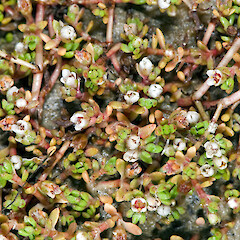Crassula kirkii
Common name
Kirk’s crassula
Synonyms
Tillaea kirkii Allan, Tillaea diffusa Kirk nom. illeg.
Family
Crassulaceae
Flora category
Vascular – Native
Endemic taxon
Yes
Endemic genus
No
Endemic family
No
Structural class
Herbs - Dicotyledons other than Composites
NVS code
The National Vegetation Survey (NVS) Databank is a physical archive and electronic databank containing records of over 94,000 vegetation survey plots - including data from over 19,000 permanent plots. NVS maintains a standard set of species code abbreviations that correspond to standard scientific plant names from the Ngä Tipu o Aotearoa - New Zealand Plants database.
CRAKIR
Chromosome number
2n = c.78, c.84
Current conservation status
The conservation status of all known New Zealand vascular plant taxa at the rank of species and below were reassessed in 2017 using the New Zealand Threat Classification System (NZTCS) – more information about this can be found on the NZTCS website. This report includes a statistical summary and brief notes on changes since 2012 and replaces all previous NZTCS lists for vascular plants.
Please note, threat classifications are often suggested by authors when publications fall between NZTCS assessment periods – an interim threat classification status has not been assessed by the NZTCS panel.
- Conservation status of New Zealand indigenous vascular plants, 2017 . 2018. Peter J. de Lange, Jeremy R. Rolfe, John W. Barkla, Shannel P. Courtney, Paul D. Champion, Leon R. Perrie, Sarah M. Beadel, Kerry A. Ford, Ilse Breitwieser, Ines Schönberger, Rowan Hindmarsh-Walls, Peter B. Heenan and Kate Ladley. Department of Conservation. Source: NZTCS and licensed by DOC for reuse under the Creative Commons Attribution 4.0 International licence.
2017 | At Risk – Naturally Uncommon | Qualifiers: DP, Sp
Previous conservation statuses
2012 | At Risk – Naturally Uncommon | Qualifiers: Sp
2009 | At Risk – Naturally Uncommon | Qualifiers: DP
2004 | Gradual Decline
Distribution
Present in New Zealand in sites along the South Wellington coast and on Stewart Island, parts of the West Coast and Southland. Also on the Chatham Islands.
Habitat
Brackish stream sides and turf, near lagoons or estuaries and at coastal stream mouths.
Wetland plant indicator status rating
Information derived from the revised national wetland plant list prepared to assist councils in delineating and monitoring wetlands (Clarkson et al., 2021 Manaaki Whenua – Landcare Research Contract Report LC3975 for Hawke’s Bay Regional Council). The national plant list categorises plants by the extent to which they are found in wetlands and not ‘drylands’. The indicator status ratings are OBL (obligate wetland), FACW (facultative wetland), FAC (facultative), FACU (facultative upland), and UPL (obligate upland). If you have suggestions for the Wetland Indicator Status Rating, please contact: [Enable JavaScript to view protected content]
FAC: Facultative
Commonly occurs as either a hydrophyte or non-hydrophyte (non-wetlands).
Detailed description
A creeping mat-like, moss-green to reddish-green, succulent herb, rooting freely at leaf nodes. Its leaves are linear-elliptic to oblong in shape, with blunt to pointed leaf tips. Flowers are miniscule, star-like, borne in leaf axils and are usually pink, pinkish-white, only rarely white or tinged green.
Similar taxa
Perhaps closest to C. ruamahanga but a large plant which has broadly obtuse leaves (these often turning reddish in exposed situations - a colour never seen in C. ruamahanga), and usually larger pink flowers with ovate to elliptic ovate petals. Cytologically this species has 2n = 84 chromosomes while C. ruamahanga have 2n = 42.
Flowering
Flowers may be found throughout the year
Flower colours
Red/Pink, White
Fruiting
Fruits may be found throughout the year
Life cycle
Minute follicles are dispersed by wind and water and possiblty also by attachment (Thorsen et al., 2009).
Propagation technique
Easily grown from the division of whole plants and fresh seed. Grows very easily with spontaneous plants readily arising from seed in cultivation. Can become a troublesome weed in some garden situations.
Threats
This species requires open sites near brackish streams, lagoons and estuaries. Provided the turf habitats it occupies are kept open and free of taller vegetation Crassula kirkii is easily maintained. In New Zealand populations have declined in the northern part of its range due to weed invasions and coastal development.
Etymology
crassula: From the Latin crassus ‘thick’, meaning ‘rather thick’
kirkii: After Thomas Kirk (18 January 1828 - 8 March 1898), a NZ botanist and lecturer in natural sciences and regarded as a leader of botanical enquiry in NZ for over three decades. One of his most significant publications was Forest flora of NZ (1889) but he also contributed over 130 papers to the Transactions and Proceedings of the NZ Institute and other journals.
Where To Buy
Not commercially available. However, plants are held by several specialist native plant nurseries and at least one university. Due to its weedy nature it is unlikely to be widely grown. Nevertheless plants have potential as a ground cover in poorly drained soils, and will grow in heavy shade or strong sun. The pinkish-white flowers are pleasantly scented, and in strong light the foliage often turns dark red.
Attribution
Fact Sheet prepared for NZPCN by P.J. de Lange 1 February 2008. Description based on Webb et al. (1988)
References and further reading
Webb CJ, Sykes WR, Garnock-Jones PJ 1988. Flora of New Zealand. Vol. IV. Botany Division, DSIR, Christchurch.
Thorsen, M. J.; Dickinson, K. J. M.; Seddon, P. J. 2009. Seed dispersal systems in the New Zealand flora. Perspectives in Plant Ecology, Evolution and Systematics 11: 285-309
NZPCN Fact Sheet citation
Please cite as: de Lange, P.J. (Year at time of access): Crassula kirkii Fact Sheet (content continuously updated). New Zealand Plant Conservation Network. https://www.nzpcn.org.nz/flora/species/crassula-kirkii/ (Date website was queried)


